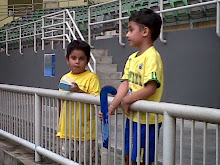26/07/2003
IF you are in South Africa, a glimpse of the Big Five in their natural
habitat is a must, so the Malaysian journalists covering the Champions
Challenge decided to pool their resources and go on a mini tour yesterday.
The best place would have been the Kruger National Park, but not only
was it out of our budget, but also too large to travel around within the
limited time we had.
So, we went to the nearest Big Five (Lion, Rhinoceros, Elephant,
Hippopotamus, and Buffalo), which was a two-hour drive from the hotel, but
were told not to expect too much.
The Philensberg Park is about 80,000 hectares and house to a myriad of
South African animals left to roam in the wild. Unlike in zoos where the
animals are in cages and the humans are free to walk - in South Africa,
the animals are left to roam free while the humans are in a metal box
(cars) and not advised to venture outside because they might turn into a
snack for some of the predators roaming the park.
The journey took us past a flea market, a mile long, and selling wares
that could turn a window shopper into a big spender.
African woodcarvings are a marvel because every detail is cleverly
chipped from ironwood, and the animals look very handsome and majestic.
Face masks of every design, some used in tribal rituals were aplenty, but
their fierce designs were not of our taste.
Kudu statues, which are almost extinct in the wild, fetched the highest
price, but the bargains at the flee market were almost 80 percent cheaper
than what one would get at the classy shopping complexes in Randburg or
other big cities.
We only had an hour, so there was a flurry of bargaining done in the
short span, and the van was almost half filled when we resumed our journey
to the Big Five.
The Philensberg Park, very small in scale compared to what South Africa
has to offer, was a big letdown in the first 30 minutes of travel because
the only animals we saw were hippopotamus and small birds.
Our guide, farmer Danny who turned into a tour guide because he wanted
to do something else in life, was hell-bent on showing us a glimpse of the
bigger animals so we started to get off the tarred road and roam around
the dirt tracks.
And the journey became tolerable because out jumped a herd of zebras in
front of us, the leader cautious at first, but slowly became cocky and led
his herd to the water's edge to quench their thirst.
Next was a herd of waterbucks, which according to our guide, was the
last resort for hungry lions.
"Waterbucks are not preferred as meals because the moment they are
killed, their meat starts emitting a strong odor which the lions dislike.
But if they do not have a choice, hungry lions are known to pounce on
waterbucks as a last resort," said Danny.
It was clear to see that elephants had ravaged the park as trees were
either stripped of their bark or smashed to pieces. But we only managed to
catch a glimpse of two bull elephants because they like to rest in the
shade under the hot afternoon sun.
Giraffes and wilderbeasts were only in small groups, but we never found
the lions but overall, the budget tour was exhilarating.
The next stop was Sun City, and it was like travelling back home to the
Sunway Lagoon Resort back home. The only difference was that Sun City had
a casino and the theme park was home to magnificent statues of African
animals.
We tried our hands at the one-arm-bandit, but like the Malaysian hockey
players, luck was not on our side.
(END)
skip to main |
skip to sidebar



The Blogger's Family

The Blogger at the top of the 4,095m Mount Kinabalu in Sabah on June 13, 2008. This was the second climb. The first was in 1993.


TBSS was established in 1924, and this blogger studied there from 1981-1987.
RESPECTABLE LINKS
Kuala Lumpur |
ESPECIALLY FOR U, MR RACIST...

I PISS ON.....

Hockey News
ALWAYS HAPPY

The Blogger's Family
ON A HIGH

The Blogger at the top of the 4,095m Mount Kinabalu in Sabah on June 13, 2008. This was the second climb. The first was in 1993.
Always Somewhere..

- Jugjet Singh
- Sports Journalist with the New Straits Times since 1994. My main beat is field hockey, so this blog will have stories that I have written for the NST, as well as hockey news from around the globe. There will be regular updates. I was also the Secretary General of the National Press Club, Malaysia for three terms (six years).
Live Traffic Feed
Blog Archive
- ► 2018 (212)
- ► 2016 (241)
- ► 2015 (299)
- ► 2014 (260)
- ► 2013 (445)
- ► 2012 (564)
- ► 2011 (430)
- ► 2010 (504)
- ► 2009 (467)
- ► 2008 (270)
-
▼
2007
(1036)
-
▼
October
(78)
-
▼
Oct 07
(17)
- Champs Tenaga keep title on sight
- Bad goalkeeping our downfall
- Malaysia sink to rock bottom
- Little respect for 'chicken Malaysia'
- Going wild in untamed South Africa
- Fifth or sixth at best
- On a kamikaze mission
- Malaysia back to old self
- All six equally balances, says Hendriks
- A win for malaysia, finally
- Home away from home
- England can be beaten
- Malaysia outplayed by 13-man South Africa
- Randburg misery continues
- Spain bent on title
- Nightmare for Malaysia
- Malaysia ready to push back when shoved
-
▼
Oct 07
(17)
-
▼
October
(78)
Tunku Besar Secondary School, Tampin.

TBSS was established in 1924, and this blogger studied there from 1981-1987.